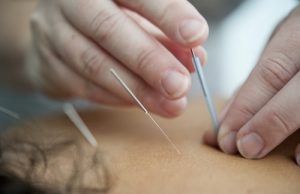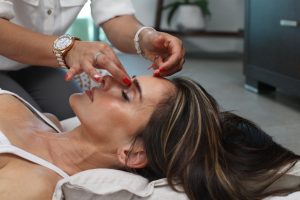What is Acupuncture?
Acupuncture is a component of traditional Chinese and Western Medicine. It involves inserting very thin/fine needles into certain points on your body targeting the nerves or energy points in the body. This treatment helps to reduce pain and improve function. At PhysioNow, many of our physiotherapists perform acupuncture treatment for many orthopedic conditions. One of the most common reasons, patients seek out acupuncture is for the treatment of headaches.
Types of Acupuncture and its benefits for headaches
There are 2 types of acupuncture:
- Chinese Acupuncture
- This approach stimulates specific pressure points, which restores the flow of positive energy throughout your body and removes the negative energy that is causing pain.
- Western/medical Acupuncture
- This type stimulates various systems of your body (for example, the nervous system and vascular system) to promote a healing response.
- The points where needles are inserted stimulate the nerves to release hormones such as endorphins that trigger a response from your body.
- This nervous and circulation system stimulation is believed to relieve headaches and migraines.
Both types of treatment have a common goal – the reduction of headaches and improvement of function.
Does Acupuncture really work?
Since acupuncture is a different form of treatment, there is always a question of whether it actually works. However, many research studies have consistently shown that acupuncture treatment provided better pain relief compared with usual care, which did not include acupuncture.
Types of headaches commonly treated with acupuncture
The research shows that treatment has been most effective for:
- Migraines
- Cervicogenic headaches
- headache on one side of head or eye radiating from neck
- Occipital headaches
- headache behind the head
- However other types of headaches could also be treated depending on patient’s assessment and healthcare professional’s skill and knowledge.
- Common points used for headaches are:
- Yintang: between the eyebrows

- DU 20: top center of head
- GB20: Back of the neck, halfway between the spine and the ears, just under the base of the skull
- Li4: In the fleshy bit between the thumb and first finger, in the V where the bones meet.
- UB 10 – Along the same line as GB 20, closer to the spine
- Yintang: between the eyebrows
What are the risks associated with treatment?
Acupuncture itself carries little risk when done by a qualified practitioner. However there are some common mild side effects of the treatment, including:
- Bruising
- Fatigue
- Soreness
Additionally, most people feel tiny pricks with the needles during treatment. However, some people won’t feel anything at all. Regardless of the sensation of the needles, acupuncture will not make any of your symptoms feel worse. If you speak with your practitioner about concerns you have about discomfort, you might feel calm going into the procedure.
It is important to note that acupuncture treatment using substandard or dirty equipment can pose a very serious health risk for infection. Treatment needles are regulated by the U.S. Food and Drug Administration and are only supposed to be single-use.
At PhysioNow, we make sure to explain the process of the treatment and all the possible risk and side effects to make sure patients have a good understanding of the treatment. Our treatment is always hygienic, minimizing the risk of infection and we never re-use the needles.
What are some tips to make sure you have a safe experience?
Make sure to do your homework on your acupuncturist before booking your first appointment, and leave the appointment if you don’t feel comfortable. Furthermore, your therapist needs to be using sterile, single use needles. Don’t be afraid to ask questions about what is going on. A good therapist will walk you through the procedure and make sure it’s a calm and safe experience for you.
However, it’s important to note that acupuncture by itself may not be enough to treat chronic headache pain. Migraines, tension headaches, and cluster headaches that impair your daily life should be addressed with pain medication and exercise along with it.
General guidelines for treatment
There’s no special preparation prior to a treatment session. If it’s your first time, you may want to go with a list of questions. Your practitioner will be able to advise you on how many treatments you should expect, and how often you might need to go to experience relief of your symptoms.
A clinical study of acupuncture for cluster headaches recommended treatment twice a week for two weeks followed by one treatment per week for eight weeks, and maintenance treatments of once every other week after that.
Who can perform acupuncture and is there coverage for it?
As mentioned above there are two types of acupuncture: Chinese and medical. An acupuncturist who completes 2-3 years of training from a recognized school holds a license to practice acupuncture. This is usually a Chinese Acupuncture practitioner and some health insurance companies offer coverage for this service.
Additionally, regulated health professionals can also provide Chinese or Medical Acupuncture after completing certain hours of training from a recognized school.
Extended health care insurance may cover acupuncture performed by an acupuncturist. Additionally, regulated health professionals like physiotherapists and massage therapists can also perform acupuncture and coverage may be available through those professions.
Benefits of acupuncture with physiotherapy
Importantly, a combined or integrated treatment approach is better than doing one form of treatment. More specifically, combining acupuncture with physiotherapy enhances the effectiveness of each treatment. Furthermore, certain types physiotherapy treatments like manual therapy can be very painful for some patients. For example, cervicogenic headaches usually require physiotherapy treatment techniques like manual therapy and exercises. However, high pain levels and severe headaches will make manual therapy and exercises difficult to tolerate. Instead, combining both treatments will help reduce this pain and headache and make manual therapy and exercises more tolerable to patients. This will lead to faster reduction in the patient’s symptoms and boosting recovery for a longer duration.
At PhysioNow we provide both Chinese and Western acupuncture. If you need more information we will be happy to provide a consultation with our practitioners. Call PhysioNow today to book your treatment session!



Leave a Reply